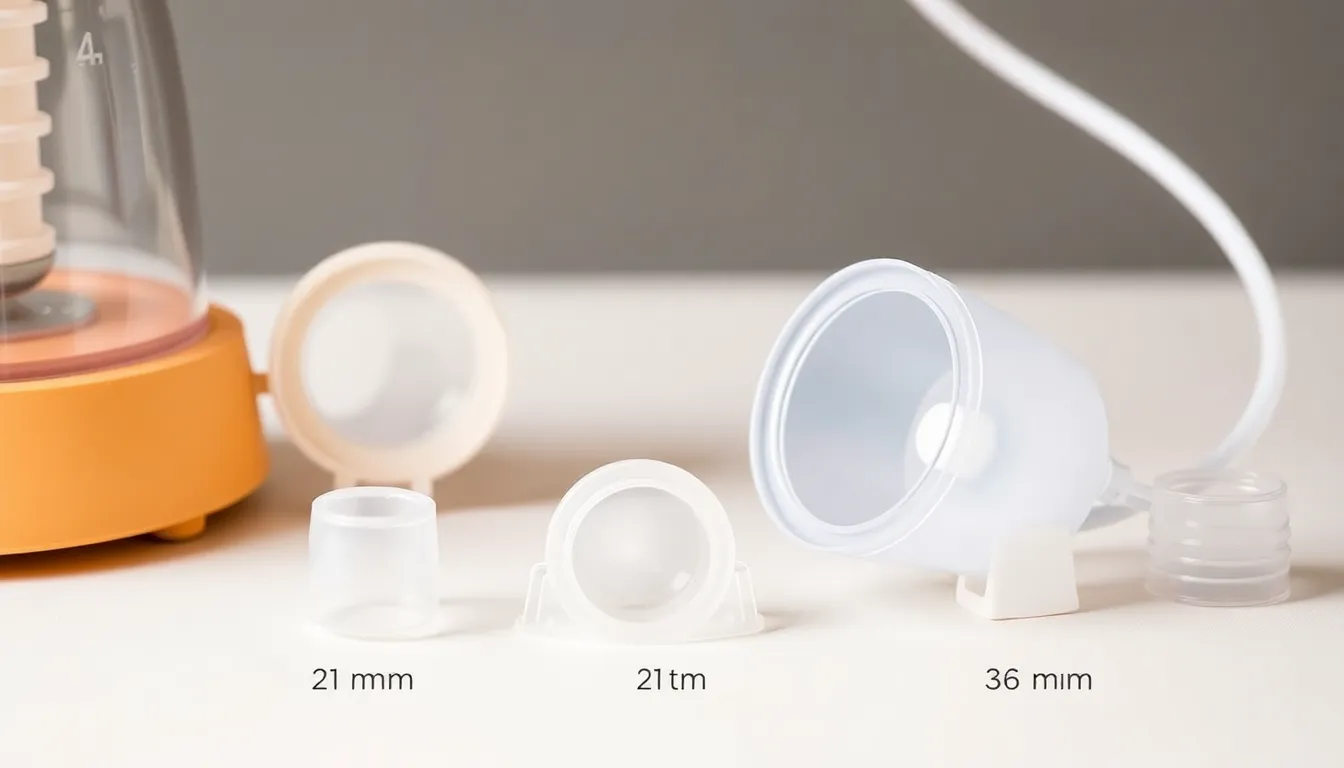Finding the right flange size can feel like a treasure hunt, but it’s one that pays off big time. Imagine the comfort of a perfect fit, like slipping into your favorite pair of shoes. Measuring your nipple for flange size isn’t just a task; it’s a crucial step toward a smoother pumping experience.
Table of Contents
ToggleUnderstanding Flange Size
Flange size plays a crucial role in the efficiency of breast pumping. Proper sizing ensures a comfortable experience, preventing issues such as soreness or decreased milk flow. Standards exist for breast flange sizing, including sizes ranging from 21mm to 36mm. Each size corresponds to the diameter of the flange opening.
Different flanges suit different nipple shapes and sizes. Measuring the nipple correctly is vital for identifying the appropriate flange size. Start by measuring the base of the nipple, just before the areola. A tape measure or ruler provides accurate readings, allowing for a better fit.
Nipple size can change over time, especially during breastfeeding. Monitoring these changes ensures ongoing comfort and efficiency. Many pumps include multiple flange sizes, which accommodate variations in nipple size. Switching flanges helps optimize the pumping experience as needs evolve.
Comfort and effectiveness correlate directly with flange size selection. An ill-fitting flange may cause discomfort and reduce milk expression. This highlights the importance of proper measurement and periodic reassessment of flange size.
Consulting with lactation specialists can provide additional guidance. They can recommend the right size based on individual needs. Regular adjustments to flange size can improve pumping efficiency, enhancing the overall experience.
Importance Of Proper Flange Sizing

Finding the correct flange size is crucial for an effective and comfortable pumping experience. A proper fit not only enhances comfort but also aids in achieving optimal milk expression.
Comfort And Fit
Comfort plays a significant role during pumping sessions. A correctly sized flange minimizes friction and irritation, preventing soreness around the nipple. Different nipple shapes necessitate various flange sizes, ensuring a secure fit. Adjusting flange sizes can lead to a noticeable improvement in comfort. Many brands offer a range of sizes, including standard options between 21mm to 36mm. Regularly reassessing flange fit is important, as nipple size may change postpartum.
Milk Expression Efficiency
Milk expression efficiency directly correlates with flange size. An ideal fit enhances suction, allowing for more effective milk removal. Poorly fitting flanges can lead to decreased milk flow and increased time spent pumping. Research indicates that using the right flange size can increase milk output significantly. Choosing the correct size may also reduce the risk of clogged ducts. Pumping efficiently helps maintain supply for breastfeeding, supporting overall feeding goals.
How To Measure Nipple For Flange Size
Finding the right nipple measurement is crucial in selecting the proper flange size. Accurate measurement promotes comfort and efficiency during pumping.
Required Tools
Gathering the right tools simplifies the measuring process. You’ll need a ruler or measuring tape, a piece of paper, a pen, and a mirror. A ruler or tape measures nipple diameter at the base. Paper and pen help document measurements accurately. Using a mirror assists in achieving a clear view during measurements.
Step-By-Step Measuring Process
Start by positioning yourself comfortably with the mirror in front. Look for the base of the nipple, just before the areola, since this is the measurement point. Gently pinch the nipple to ensure it’s upright. Use the ruler or tape to measure the diameter at the widest point of the base.
Note both the centimeters and millimeters for precise sizing. Record the measurement carefully. Measuring consistently helps maintain accuracy, especially if changes occur over time. After measuring, compare the recorded size against the available flange sizes to determine the best fit for comfort and efficiency.
Common Mistakes To Avoid
Avoiding common mistakes during the measurement process enhances the chances of achieving the right flange size. Rushing through the measurement often leads to inaccuracies. Take time to ensure that measurements are precise, as even a few millimeters can make a difference.
Neglecting to measure at the base of the nipple presents another problem. This area, just before the areola, provides the most accurate diameter for flange fitting. Skipping this step can result in selecting a size that feels uncomfortable or ineffective.
Using the wrong tools complicates the measuring process. A ruler or measuring tape is essential for accurate readings. Remember to hold the measuring tool firmly against the skin without compressing the tissue. Compression alters the true size of the nipple and skews results.
Many individuals forget to document measurements properly. Recording sizes helps compare with flange options and ensures consistency during future assessments. Checking measurements regularly is critical because nipple size may change over time, especially with hormonal fluctuations.
Overlooking the importance of comfort in flange selection can have negative consequences. A poorly fitted flange can lead to soreness or reduced milk flow. Finding a size that feels comfortable encourages consistent pumping, which supports breastfeeding goals.
Considering flange sizing only once also proves to be a mistake. Regular adjustments based on changes in nipple size or shape can optimize the pumping experience. Consulting with a lactation specialist may also provide personalized insights for ongoing comfort and effectiveness during breastfeeding.
Tips For Choosing The Right Flange Size
Selecting the appropriate flange size enhances the pumping experience significantly. Start by measuring the nipple accurately at its base, just before the areola. Use a ruler or measuring tape for this process to ensure precision.
Document all measurements meticulously. Comparing measurements against standard flange sizes helps identify the best fit. It’s important to consider individual differences; some people may require an unconventional size.
Explore different flange options available for purchase. Many breast pumps come with a variety of sizes, accommodating the natural variations in nipple shape and size. Trying multiple sizes might provide insights into what feels most comfortable and effective.
Assess comfort levels while using the flange. If discomfort arises during pumping, reconsider the flange size. A properly fitted flange ensures minimal friction and irritation, reducing the risk of soreness and enhancing milk expression.
Reassess flange size periodically throughout the breastfeeding journey. Over time, nipple size can change, particularly during and after breastfeeding sessions. Regular adjustments can optimize comfort and efficiency during pumping.
Consulting with a lactation specialist proves beneficial for personalized guidance. They can offer tailored advice and recommend suitable flange sizes based on individual measurements and breastfeeding goals. Ensuring the right flange fit enhances the overall experience, promoting both comfort and successful milk expression.
Finding the right flange size is key to a successful pumping experience. Accurate nipple measurement ensures comfort and efficiency while preventing issues like soreness and reduced milk flow. Regularly reassessing flange fit is crucial as nipple size can change over time.
By taking the time to measure properly and selecting the appropriate flange, individuals can significantly enhance their pumping sessions. Exploring different sizes and consulting with a lactation specialist can provide valuable insights. Ultimately, a well-fitted flange not only supports breastfeeding goals but also promotes overall comfort during the journey.




